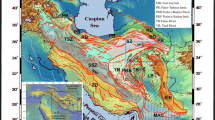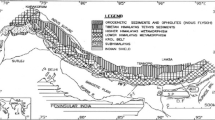Abstract
The Himalayan belt is known for seismic activities; however, activities across this belt are not uniform due to various factors, including stress regime, heterogeneity of subsurface material, and the manner by which the major tectonic Indian plate is colliding with the Eurasian plate. In this study, three sample regions spanning northwest to northeast Himalayas (Kashmir, Nepal, and northeast Himalayan regions) were selected, and their b-values and fractal dimensions from the investigation period of 1973–2015 were calculated. Subsequently, the b-value was calculated via the Gutenberg–Richter relation and maximum likelihood method, whereas the fractal dimension or D-value was calculated using the correlation integral technique. Upon subdividing the time duration into six equal interval subsets, a variation in b-value can be observed over the years. The period 1973–2015 was selected to ensure the sufficiency of data in each subset and an adequate number of subsets for comparisons. From the low b-values, possible high-stress regions and asperities can be inferred, and the variation in stress and heterogeneity of material can be observed from the northwest to northeast Himalayas. An increase in b-value was observed on moving from the northwest to northeast Himalayas during the period of investigation. From the D-value, the extent of the epicentre cluster was observed, revealing that the epicentres were far more clustered to a point in Nepal Himalayas than in the two other regions. The spatial distribution of epicentres was more or less in 1D (fractal dimension) in the northeast and northwest Himalayas, indicating their distribution along particular geological linear features, such as major faults. Hence, a comparative study of the three regions was achieved. On the basis of the b-value, the types of fault and tectonics can be predicted, and the frequency of earthquakes in these Himalayan regions can be better understood.








Similar content being viewed by others
References
Aki K (1965) Maximum likelihood estimate of b-value in the formula logN= a-bM and its confidence limits. B Earthq Res I Tokyo 43:237–239
Aki K (1981) Source and scatering effects on the spectra of small local earthquakes. B Seismol Soc Am 71(6):1687–1700
Bachmann C, Wiemer S, Goertz-Allmann B, Woessner J (2012) Influence of pore-pressure on the event-size distribution of induced earthquakes. Geophys Res Lett 39:L09302
Bak P, Tang C (1989) Earthquakes as a self-organized criticality phenomenon. J Geophys Res 94(B11):15635–15637
Bender B (1983) Maximum likelihood estimation of b-values for magnitude grouped data. B Seismol Soc Am 73:831–851
Chen CC, Wang WC, Chang YF, Wu YM, Lee YH (2006) A correlation between the b-value and the fractal dimension from the aftershock sequence of the 1999 Chi-Chi, Taiwan, earthquake. Geophys J Int 167(3):1215–1219
Dimri V (1997) Application of fractals in seismology with reference to Koyna region. Lecture Notes of workshop on application of fractals in earth sciences, N.G.R.I. Hyderabad, India 119–126
Enescu B, Ito K, Radulian M, Popescu E, Bazacliu O (2005) Multifractal and chaotic analysis of Vrancea (Romania) intermediate-depth earthquakes-Investigation of the temporal distribution of events. Pure Appl Geophys 162(2):249–271
Enescu B, Enescu D, Ito K (2009) Values of b and p: their variations and relation to physical processes for earthquakes in Japan and Romania. Rom J Physiol 56(3–4):590–608
Farrell J, Husen S, Smith R (2009) Earthquake swarm and b-value characterization of the Yellowstone volcano-tectonic system. J Volcanol Geotherm Res 188:260–276
Gerstenberger M, Wiemer S, Giardini D (2001) Asystematic test of the hypothesis that the b-value varies with depth in California. Geophys Res Lett 28:57–60
Ghosal A, Ghosh U, Kayal JR (2012) A detailed b-value and fractal dimension study of the March 1999 Chamoli earthquake (Ms 6.6) aftershock sequence in western Himalaya. Geomat Nat Haz Risk 3(3):271–278
Harris RA (2003) Introduction to special section: Stress triggers, stress shadows, and seismic hazard. J Geophys Res 103:24,347–24,358. https://doi.org/10.1016/S0074-6142(03)80187-0
Henderson J, Main IG, Pearce RG, Takeya M (1994) Seismicity in the North-Eastern Brazil: fractal clustering and the evolution of the b-value. Geophys J Int 116:217–226
Henderson JR, Barton DJ, Foulger GR (1999) Fractal clustering of induced seismicity in the Geysers geothermal area, California. Geophys J Int 139(2):317–324
Hirata T (1989a) Fractal dimension of fault systems in Japan: fractal structure in rock fracture geometry at various scales. Pure Appl Geophys 131:157–170
Hirata T (1989b) A correlation between the b-value and the fractal dimension of earthquakes. J Geophys Res 94:7507–7514
Jena R, Pradhan B, Beydoun G, Sofyan H, Affan M (2019) Integrated model for earthquake risk assessment using neural network and analytic hierarchy process: Aceh province, Indonesia. Geosci Front 11:613–634. https://doi.org/10.1016/j.gsf.2019.07.006
Jena R, Pradhan B, Beydoun G, Al-Amri A, Sofyan H (2020) Seismic hazard and risk assessment: a review of state-of-the-art traditional and GIS models. Arab J Geosci 13(2):50
Kagan Y (1993) Statistics of characteristic earthquakes. B Seismol Soc Am 83:7–24
Kagan Y (1994) Observational evidence for earthquakes as a nonlinear dynamic process. Physical D 77:160–192
Khilyuk LF, Chilingar GV, Robertson JO, Endres JB (2000) Chapter 14 - Progress in Developing a Forecasting System, Preferential Precursors, and Monitoring Network. Gas Migration 2000:209–219. https://doi.org/10.1016/B978-088415430-3/50015-X
Knopoff L (2000) The magnitude distribution of declustered earthquakes in Southern California. Proc Natl Acad Sci U S A 97:11880–11884
Kumar S (2012) Seismicity in the NW Himalaya, India: fractal dimension, b-value mapping and temporal variations for hazard evaluation. Geosci Res 3(1):83–87
Kumar S, Sushil R, Joshi D (2011) Fractal dimension and b-VALUE Mapping in the NW Himalaya and Adjoining Regions, India. Adv Geosci 12:83–96
Kumar A, Rai S, Joshi A, Mittal H, Sachdeva R, Kumar R, Ghangas V (2013) The b-value and fractal dimension of local seismicity around Koyna Dam (India). Earthq Sci 26(2):99–105
Lamessa G, Mammo T, Raghuvanshi TK (2019) Homogenized earthquake catalog and b-value mapping for Ethiopia and its adjoining regions. Geoenvironmental Disasters 6:1–24
Mandal P, Rastogi BK (2005) Self-organized fractal seismicity and b value of aftershocks of the 2001 Bhuj earthquake in Kutch (India). Pure Appl Geophys 162(1):53–72
Miyamura S (1962) Magnitude–frequency relation of earthquakes and its bearing on geotectonics. Proc Jpn Acad 38:27–30
Mori J, Abercrombie RE (1997) Depth dependence of earthquake frequency-magnitude distributions in California: implications for the rupture initiation. J Geophys Res 102:15081–15090
Okal EA, Romanowicz BA (1994) On the variation of b-values with earthquake size. Phys Earth Planet Inter 87:55–76
Pacheco JF, Scholtz CH, Sykes LR (1992) Changes in frequency-size relationship from small to large earthquakes. Nature 355:71–73
Reasenberg P (1985) Second-order moment of Central California seismicity, 1969–1982. J Geophys Res 90(7):5479–5495
Scholz C (1968) The frequency-magnitude relation of micro fracturing in rock and its relation to earthquakes. B Seismol Soc Am 58:399–415
Singh C (2016) Spatial variation of seismic b-values across the NW Himalaya. Geomat Nat Haz Risk 7(2):522–530
Smith WD (1981) The b-value as an earthquake precursor. Nature 289:136–139
USGS (2018) Advanced national seismic system comprehensive catalog and important caveats, provided by USGS earthquake archives http://earthquake.usgs.gov/earthquakes/search/. Assessed on 14 Mar
Utsu T (1965) A method for determining the value of b in a formula log n = a – Bm showing the magnitude-frequency relation for earthquakes. Geophys B13:99–103
Utsu T (1966) A statistical significance test of the difference in b-value between two earthquake groups. J Phys Earth 14:34–40
Van Stiphout T, Zhuang J, Marsan D (2012) Seismicity declustering, community online resource for statistical seismicity analysis. 1–24. https://doi.org/10.5078/corssa-52382934.
Wang KL, Lin ML (2010) Development of shallow seismic landslide potential map based on Newmark’s displacement: the case study of Chi-Chi earthquake, Taiwan. Environ Earth Sci 60(4):775–785
Weichert DH (1980) Estimation of the earthquake recurrence parameters for unequal observation periods for different magnitudes. B Seismol Soc Am 70(4):1337–1346
Wiemer S, Wyss M (1997a) Mapping the frequency-magnitude distribution in asperities: an improved technique to calculate recurrence times. J Geophys Res 102:15115–15128
Wiemer S, Wyss M (1997b) Mapping the frequency-magnitude distribution in asperities: an improved technique to calculate recurrence times? J Geophys Res-Sol Ea 102(B7):15115–15128
Wiemer S, Wyss M (2000) Minimum magnitude of completeness in earthquake catalogs: examples from Alaska, the Western United States and Japan. B Seismol Soc Am 90:859–869
Wyss M (1973) Towards a physical understanding of the earthquake frequency distribution. Geophys J Int 31:341–359
Wyss M, Sammis CG, Nadeau RM, Wiemer S (2004) Fractal dimension and b-value on creeping and locked patches of the San Andreas fault near Parkfield, California. B Seismol Soc Am 94(2):410–421
Acknowledgements
The authors would like to express their gratitude to the University of Technology Sydney that provided the financial support and the two anonymous reviewers for their constructive comments to improve the manuscript.
Funding
This research is supported by the Centre for Advanced Modelling and Geospatial Information Systems (CAMGIS), Faculty of Engineering & IT, in the University of Technology Sydney (UTS).
Author information
Authors and Affiliations
Corresponding author
Ethics declarations
Conflict of interest
The authors declare that they have no competing interests.
Additional information
Responsible Editor: Amjad Kallel
Rights and permissions
About this article
Cite this article
Jena, R., Ghansar, T.A.A., Pradhan, B. et al. Estimation of fractal dimension and b-value of earthquakes in the Himalayan region. Arab J Geosci 14, 867 (2021). https://doi.org/10.1007/s12517-021-07271-4
Received:
Accepted:
Published:
DOI: https://doi.org/10.1007/s12517-021-07271-4




